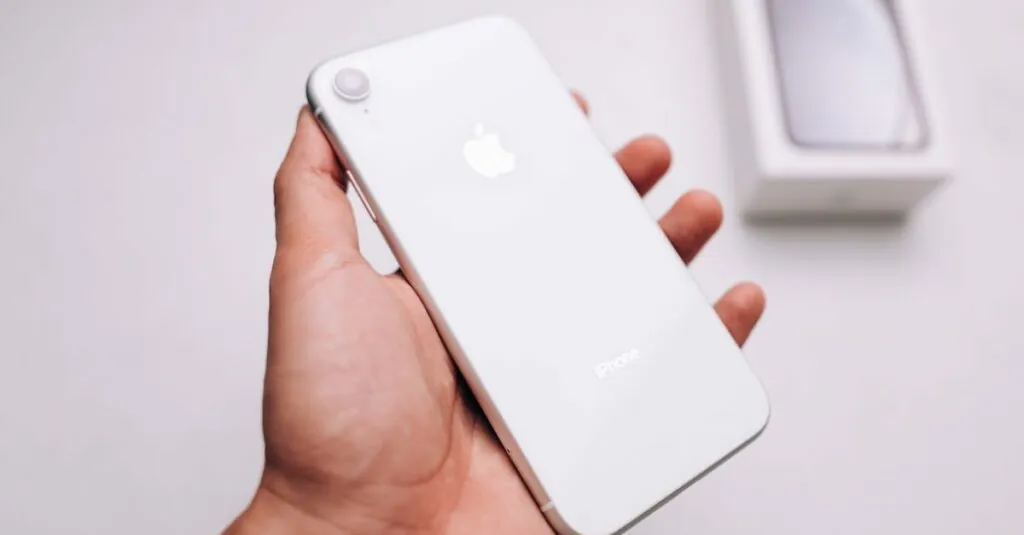Table of Contents
ToggleImagine this: you’re eagerly waiting for that important call, but your iPhone’s ringer is as silent as a ninja in a library. It’s a classic scenario that leaves many scratching their heads, wondering how their phone went from a lively ring to a quiet whisper. Fear not! Getting your ringer back in action is easier than finding a lost sock in the laundry.
In this article, you’ll discover simple steps to revive your iPhone’s ringer and ensure you never miss another call. Whether you accidentally hit the mute switch or dove into the depths of your settings, turning that ringer back on is just a few taps away. Let’s dive in and bring back the sound of those incoming calls—because who doesn’t want to feel like a VIP every time their phone buzzes?
Understanding iPhone Ringer Settings
Ringer settings play a crucial role in an iPhone’s functionality. Users depend on these settings to receive notifications and calls without missing important communication.
Importance of Ringer Functionality
Ringer functionality ensures timely notifications for incoming calls and messages. It helps maintain connectivity with friends and family. Additionally, with busy schedules, missing a call can lead to missed opportunities or vital information. An active ringer enhances safety, allowing users to remain aware of their surroundings. Quick responses become possible, especially during emergencies. This functionality serves various situations, from business meetings to social gatherings, underscoring its essential nature.
Common Reasons for Ringer Being Off
Several factors can lead to the ringer being off. Users often accidentally toggle the mute switch located on the side of the device. Another common issue arises from the Do Not Disturb mode, which silences notifications during set hours. Software updates can reset settings, causing unexpected silence. Volume levels can also inadvertently drop, reducing ringer sound. Furthermore, utilizing silent ringtones or custom alert tones may lead to confusion about ringer status. Recognizing these common problems aids in quickly restoring functionality for calls and alerts.
Checking the Physical Ringer Switch
The ringer switch plays a crucial role in managing iPhone sound settings. Its proper use can quickly resolve issues with a silent ringer.
Locating the Ringer Switch
Finding the ringer switch is straightforward. This switch is typically located on the left side of the iPhone, above the volume buttons. Users can easily toggle it up or down to determine its current position. If the orange indicator is visible, the ringer is off, meaning calls won’t produce sound. Checking this switch first ensures that users address the most common reason for missed notifications.
How to Use the Ringer Switch
Using the ringer switch is simple. To turn the ringer back on, toggle the switch upwards. The phone will then emit sounds for incoming calls and alerts. Users often notice a slight vibration indicating the switch’s movement. After adjusting, test the phone by receiving a call to confirm the ringer functions properly. Ensuring this switch is active helps maintain connection and allows users to be aware of calls and notifications in real time.
Adjusting Volume Settings
Adjusting volume settings is essential for restoring your iPhone’s ringer. Users often overlook this simple step when facing silent ringer issues.
Accessing Volume Controls
Access volume controls by using physical buttons on the side of the iPhone. Press the volume up button to increase sound levels until the desired ringer volume appears on the screen. Checking the volume indicator helps determine if the ringer is set to an adequate level. The indicator displays a speaker icon when sound is active. Users can also access settings directly by navigating to Settings, then to Sounds & Haptics. Here, the ringer and alerts volume can be adjusted. The slider should be set high enough to ensure it isn’t accidentally muted.
Using Control Center to Adjust Volume
Using Control Center offers a quick way to adjust volume settings. Swipe down from the top-right corner on newer iPhones or swipe up from the bottom on older models. Locate the volume slider, which appears as a speaker icon. Adjust the slider by dragging it up to increase ringer volume. This method provides immediate feedback, allowing users to hear any changes made. If the ringer remains silent, it may indicate other issues, prompting further investigation into additional settings or switch functions. The Control Center enables easy, fast adjustments without needing to navigate through multiple menus.
Modifying Do Not Disturb Settings
Do Not Disturb mode can silence incoming calls and notifications, causing missed connections. Turning it off is essential for restoring ringer functionality.
Turning Off Do Not Disturb
To turn off Do Not Disturb, access the Control Center by swiping down from the top right corner on iPhones with Face ID or swiping up from the bottom on older models. Tap the crescent moon icon to deactivate it. If the icon turns gray, Do Not Disturb is off, allowing calls and alerts to come through once again. Users can also navigate to Settings, then Focus, and select Do Not Disturb to switch it off. Quick adjustments can make a significant difference in connectivity.
Configuring Do Not Disturb Preferences
Configuring Do Not Disturb preferences ensures users receive alerts during critical times. Access Settings, then Focus, and tap on Do Not Disturb to customize options. Users can choose specific times for activation, allowing them to silence notifications but still receive calls from designated contacts. Enable the option to allow calls from favorites or repeated calls to ensure important calls aren’t missed. Tailoring these settings can significantly enhance user experience, allowing for a balance between focus and connectivity.
Restarting Your iPhone
Restarting an iPhone can resolve various issues, including a silent ringer. Often, a quick reboot fixes minor glitches affecting ringer settings.
How to Properly Restart Your iPhone
To restart an iPhone, begin by pressing and holding the side button along with the volume up or down button. Release the buttons when the power off slider appears on the screen. Move the slider to power off the device. After the iPhone shuts down completely, press and hold the side button again until the Apple logo appears. This simple procedure resets various functionalities, which may include restoring sound for incoming calls.
When to Consider Restarting
Consider restarting an iPhone if the ringer remains silent despite checking volume levels and the mute switch. It’s also advisable if the device shows unresponsive behavior, such as apps crashing or not opening properly. Additionally, software updates can occasionally disrupt settings, making a restart necessary. If recent changes don’t seem effective in restoring functionality, rebooting the device often resolves underlying tasks and refreshes the system.
Restoring an iPhone’s ringer is essential for staying connected and avoiding missed calls. By following the outlined steps users can easily troubleshoot and resolve issues related to silent ringer settings. Whether it’s toggling the mute switch adjusting volume levels or managing Do Not Disturb mode these simple actions can make a significant difference.
If problems persist restarting the device often proves effective in refreshing the system. With these strategies in hand users can ensure their iPhone remains an effective tool for communication. Staying proactive about ringer settings not only enhances daily interactions but also promotes safety and responsiveness in urgent situations.




